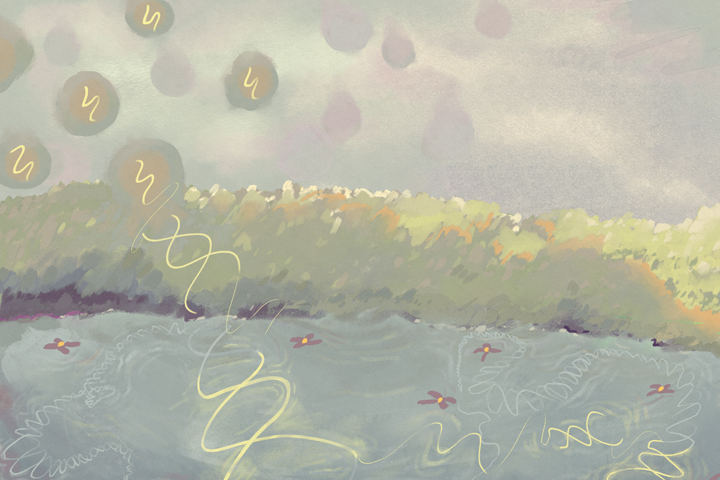Invade and Adapt – Genome Evolution via Transposable Elements
By Kit Kan 簡迎曦

In Issue 018, we introduced you to the concept of transposable elements and its discoverer, Barbara McClintock. Maybe you find it crazy that our DNA can jump around the genome, creating new insertions. Still, there are many more fascinating things about these elements. This article will take you through some of the most intriguing things about transposable elements and what they do other than jumping around.
Classification and Origin
Transposable elements (TEs) can be classified into two types based on their mechanism of insertion. Class 1 TEs are called retrotransposons. These elements jump around the genome by a copy-and-paste mechanism. The retrotransposons are first transcribed into an RNA intermediate, then reverse transcribed into DNA. This process creates a DNA segment identical to the original retrotransposon. The DNA copy is then integrated into the genome to create a new insertion. Class 2 TEs are DNA transposons that can be cut and pasted without amplification. A DNA transposon is excised from the original position and re-integrated into another part of the genome with the help of an enzyme called transposase. All TEs together make up around 50% of the human genome [1], although, throughout evolutionary, most have lost their ability to jump around.
If you are familiar with the mechanism of viral infection, you may see some resemblance between these mechanisms. Indeed, retrotransposons and a particular type of virus, retrovirus, share many similarities, such as the ability to insert their DNA, synthesized from reverse transcription, into the host genome. In fact, endogenous retrovirus (ERV; not retrovirus but viral DNA in our genome) are a type of retrotransposon, which are the remnants of viral germ-line infections millions of years ago. The viral genome was integrated into our ancestors’ genome and passed on to future generations. ERVs make up around 7-8% of the human genome [2]. In short, we are part human and part virus. (Note that not all retrotransposons can be directly traced to a viral origin.)
Regulation and Adaptation
While having viral DNA in our genome and DNA jumping around surely stun most people, these features could also be dangerous. If the host does not develop a mechanism to suppress transposition and transcription of viral DNA, it risks mutation and re-infection. Insertion of TEs into functional sequences in the genome or expression of viral proteins may cause harmful effects to the host. Luckily, our body has multiple repression mechanisms against TEs to keep us safe. The expression of genes depends greatly on the accessibility of the DNA. If a segment of DNA is open, machineries required for transcription, such as RNA polymerase, can bind to that segment and activate transcription to express the gene. However, when the DNA is condensed, those machineries cannot bind and that region of DNA is repressed (footnote 1). Epigenetic modifications are some of the ways in which TEs are repressed through altering DNA accessibility [1]. When these mechanisms are faulty, diseases may arise. Dysregulated TEs has been shown to cause neuronal death [3], hemophilia [4] and cancer.
Since most TEs are repressed and thought to be harmful to the host, for a very long time, they were called “junk DNA”, as they appear to be non-functional and solely parasitic. However, in recent years, some TEs are found to be adapted into the host genome to perform certain functions. Some TEs serve as binding sites for transcription factors (TFs), which are proteins that bind to specific regions of DNA to regulate the transcription of the gene nearby (footnote 2). A study on human and mouse cell lines revealed that, for the 26 TFs examined, around 20% of transcription factor binding sites are embedded in TEs [5]. The insertion of TEs into the genome may have provided a novel way for the cell to exert a finer control on gene expression.
From an unaccepted discovery to one of the most important concepts in modern genetics, transposable elements have revolutionized our understanding on genomes and evolution. We often see novel observable traits appear as the results of evolution as species adapting to the external environment, but transposable elements taught us that the evolution of genomes is also in action deep inside the cell.
1 Editor’s remark: Let us go beyond the curriculum for a while – phenotype is not only determined by genetic sequence or allele. This is a field in biology called “epigenetics”, which is defined as the study of phenotypical changes without alternations in the DNA sequence.
2 Transcription factor: DNA-binding proteins, which bind to specific DNA sequences to either facilitate or repress transcription. For example, you will learn in undergraduate courses that, in eukaryotes, a class of TFs called general transcription factors (GTFs) is required to initiate transcription by helping RNA polymerases locate the start site. It sits on the DNA before RNA polymerase comes. TFs can also control where and when a gene is turned on.
References:
[1] L. Pray, “Transposons: The Jumping Genes,” Nature Education, vol. 1, no. 1, pp. 204, 2008, https://www.nature.com/scitable/topicpage/transposons-the-jumping-genes-518/.
[2] P. Jern and J. M. Coffin, “Effects of Retroviruses on Host Genome Function,” Annual Review of Genetics, vol. 42, 2008, pp. 709–732.
[3] W. Sun, H. Samimi, M. Gamez, H. Zare, and B. Frost, “Pathogenic tau-induced piRNA depletion promotes neuronal death through transposable element dysregulation in neurodegenerative tauopathies,” Nature Neuroscience, vol. 21, no. 8, Aug. 2018, pp. 1038–1048.
[4] H. H. Kazazian Jr, C. Wong, H. Youssoufian, A. F. Scott, D. G. Phillips, and S. E. Antonarakis, “Haemophilia A resulting from de novo insertion of L1 sequences represents a novel mechanism for mutation in man,” Nature, vol. 332, no. 6160, 1988, pp. 164–166.
[5] V. Sundaram, et al., “Widespread contribution of transposable elements to the innovation of gene regulatory networks,” Genome Research, vol. 24, no. 12, Dec. 2014, pp. 1963–1976.